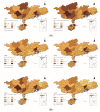Regional Differentiation and Influencing Factor Analysis of Residents' Psychological Status during the Early Stage of the COVID-19 Pandemic in South China
- PMID: 34831750
- PMCID: PMC8625310
- DOI: 10.3390/ijerph182211995
Regional Differentiation and Influencing Factor Analysis of Residents' Psychological Status during the Early Stage of the COVID-19 Pandemic in South China
Abstract
A scientific understanding of the impact of COVID-19 on the psychological status of residents is important for improving medical services and responding to public health emergencies. With the help of some of the most popular network communication tools (including Wechat and Weiboand QQ), online questionnaires were completed by South China citizens during the early stage of the COVID-19 pandemic based on psychological stress theory and using a comprehensive sampling method. Through cooperation with experts from other institutions, the content of the questionnaire was designed to include interviewees' spatial locations and individual information, identify whether negative emotions were generated, and determine the level of psychological stress and the degree of perception change, etc. According to the data type, mathematical statistics and multiple logistic regression methods were used to examine regional differentiation and influencing factors regarding the psychological stress of residents using 1668 valid questionnaires from 53 municipal administrative units in South China. The results firstly showed that over the whole area there was typical regional differentiation in South China, especially in relation to negative expression and psychological stress, with this feature reflecting the dual urban-rural structure. Secondly, regional differences were obvious. Residents of Hainan showed stronger change of psychological stress than those of the other two provinces. In contrast, Guangdong residents were the least psychological stress, and the concept of a harmonious relationship between human beings and nature was not accepted as well as in the other two provinces. Thirdly, in each province the capital city acted as the regional pole, with greater psychological status. This polarization effect decreased with greater distance, reflecting the theory of growth poles in human geography. Fourthly, gender, education level, occupation, informational correction, and the possibility of infection were notable factors that affected the psychological status of interviewees facing COVID-19. However, the functions were different and were decided by the dependent variable. Lastly, based on conclusions summarized from three perspectives, it was found that regional differentiation, public information, and social structure need to focused upon in order to handle sudden major health issues.
Keywords: COVID-19 pandemic; South China; multiple logistic regression methods; psychological status; regional differentiation.
Conflict of interest statement
The authors declare that they have no known competing financial interests or personal relationships that could appear to influence the work reported in this paper.
Figures




Similar articles
-
Satisfaction with and factors influencing rural residents' government responses to COVID-19 in the post-pandemic era.BMC Public Health. 2025 Mar 28;25(1):1174. doi: 10.1186/s12889-025-22373-4. BMC Public Health. 2025. PMID: 40155877 Free PMC article.
-
Sex differences and psychological stress: responses to the COVID-19 pandemic in China.BMC Public Health. 2021 Jan 7;21(1):79. doi: 10.1186/s12889-020-10085-w. BMC Public Health. 2021. PMID: 33413224 Free PMC article.
-
Factors Influencing Anxiety Among WeChat Users During the Early Stages of the COVID-19 Pandemic in Mainland China: Cross-sectional Survey Study.J Med Internet Res. 2021 May 17;23(5):e24412. doi: 10.2196/24412. J Med Internet Res. 2021. PMID: 33878025 Free PMC article.
-
Influences of the COVID-19 pandemic and response strategies on residents' psychological state: The survey from Hainan Island.PLoS One. 2022 Jan 20;17(1):e0261537. doi: 10.1371/journal.pone.0261537. eCollection 2022. PLoS One. 2022. PMID: 35051182 Free PMC article.
-
A Review of Influencing Factors on Spatial Spread of COVID-19 Based on Geographical Perspective.Int J Environ Res Public Health. 2021 Nov 20;18(22):12182. doi: 10.3390/ijerph182212182. Int J Environ Res Public Health. 2021. PMID: 34831938 Free PMC article.
Cited by
-
Experience of Primary Care Physicians in the Aube Department, France, Regarding the COVID-19 Crisis.Healthcare (Basel). 2022 May 5;10(5):852. doi: 10.3390/healthcare10050852. Healthcare (Basel). 2022. PMID: 35627989 Free PMC article.
-
Ecological Impacts Associated with the Qinghai-Tibet Railway and Its Influencing Factors: A Comparison Study on Diversified Research Units.Int J Environ Res Public Health. 2023 Feb 25;20(5):4154. doi: 10.3390/ijerph20054154. Int J Environ Res Public Health. 2023. PMID: 36901163 Free PMC article.
-
The impacts of innovation capability and social adaptability on undergraduates' employability: The role of self-efficacy.Front Psychol. 2022 Nov 17;13:954828. doi: 10.3389/fpsyg.2022.954828. eCollection 2022. Front Psychol. 2022. PMID: 36467135 Free PMC article.
References
-
- Cai H.L., Zhu Y.X., Lei L.B., Pan C.H., Zhu L.W., Li J.H., Gu J., Hao Y.T. Related knowledge, behaviors and psychology status of COVID-19: An internet-based cross-sectional survey. Chin. J. Public Health. 2020;36:152–155. doi: 10.11847/zgggws1128106. - DOI
-
- Tan P., Bai J.D., Chen W.H., Liu J.C. A study on the impact of individual characteristics, event severity and rescue effect on psychological trauma in wildlife conflict. Res. Environ. Yangt. Bas. 2019;28:1643–1651. doi: 10.11870/cjlyzyyhj201907014. - DOI
-
- Seyed R.M., Hamid R., Gholamreza N.B. Role of crisis management in reducing socio-psychological vulnerabilities after natural disasters (case study: Citizens of Bam City) Environ. Energy Econ. Res. 2018;2:187–196. doi: 10.22097/eeer.2018.144293.1034. - DOI
-
- Shi K., Fan H.X., Jia J.M., Li W.D., Song Z.L., Gao J., Chen X., Lu J.F., Hu W.P. The risk perceptions of SARS and socio-psychological behaviors of urban people in China. Acta Psychol. Sin. 2003;35:546–554.
Publication types
MeSH terms
LinkOut - more resources
Full Text Sources
Medical

